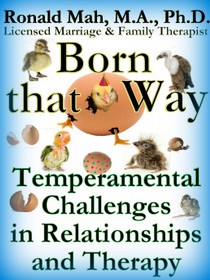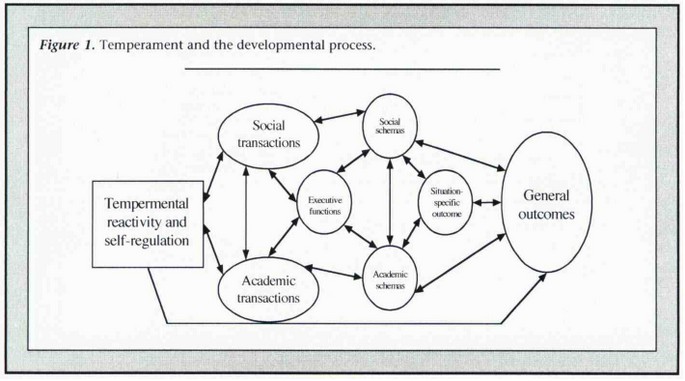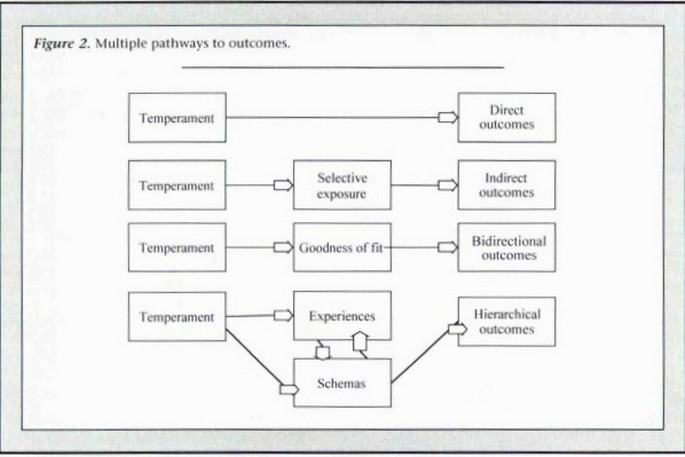7. Learning Disabilities & Temperament - RonaldMah
Ronald Mah, M.A., Ph.D.

Licensed Marriage & Family Therapist,
Consultant/Trainer/Author
Main menu:
7. Learning Disabilities & Temperament
Therapist Resources > Therapy Books > Born That Way- Termperament Rel

Born that Way, Temperamental Challenges in Relationships and Therapy
Chapter 7: LEARNING DISABILITIES AND TEMPERAMENT
by Ronald Mah

The examination of interplay among biological, social, and psychological processes for development and learning should include consideration of the interaction of temperament and learning disabilities. Lahey (2004, page 89) pointed out that temperamental traits echo descriptions of ADHD. Both Samuel and Charlie could qualify for the ADHD diagnosis. Traits used to describe negative emotionality: angry, aggressive, anxious, fearful, and depressed are used to describe individuals with ADHD. Charlie has started to show angry and depressed symptoms recently. In addition, those traits used to describe positive emotionality are antonyms of the dysphoria, anhedonia, and fatigue symptoms of depression. The commonly used descriptions of the temperament trait of attentional control resemble the description of ADHD. Since self-control is correlated with "ADHD, conduct disorder, substance abuse, and other forms of psychopathology, and these aspects of psychopathology mediate the association between self-control and functional impairment, then one could argue that self-control should be viewed as a derivative dimension of temperament…" (Lahey, 2004, page 90). Key to working with those with learning disabilities is considering the individuality of each person to optimize learning strategies and environments. Certain temperamental traits or profiles can make processing information more difficult for some individuals. Problems with processing information can make it more difficult in turn to deal with difficult temperamental traits. Temperament and learning disabilities can interact and intensify problems for these individuals. The reactions can further affect others such as parents, teachers, and peers negatively. The negative reactions of others then create the social and learning environment that affects the individual. "Accordingly, viewing the emotional needs of children with LD as stemming from learning problems may be less appropriate than viewing the individual in terms of a set of basic dispositions that include temperament and learning processes that reciprocally influence one another (Abrams, 1991)" (Teglasi et al., 2004, page 13).



"As shown in Figure 1, temperamental reactivity and self-regulation, associated with the biological systems of the brain, set down the patterns of reactions to stimuli, but it is the continuous process of learning through interactions with social and academic environments that shapes outcomes" (Teglasi et al., 2004, page 13). This chart can be used to understand Charlie or Samuel and their school struggles: Charlie currently and Samuel when he was a child. Substitution of "Family or couple's transactions" for "Academic transactions" would give indication of how temperament and the developmental process affect relationship of a couple like Samuel and Aliya. The social transactions between partners in a couple are affected by the demands of the couple's or family's household, financial, extended family, other social activities, and so forth. Both are affected by an individual's degree of temperamental reactivity and ability to self-regulate. General intelligence and learning internalized and developed by executive functioning guide the individual's responses, but not exclusively because of the influence of temperament. In addition, executive functioning can be negatively affected by learning disabilities. Out of the social transactions with primary caregivers, the individual develops social schemas. And, out of the demands negotiating life in the family relationships, the individual develops life/relationship schemas. These models or templates of how "things" and "people" work are applied and given specific situations, the outcomes become generalized. Teglasi's chart only suggests the complexity of dynamics, but clearly notes temperament as a key if not core component of individual personality and behavior. Assessment of individual and couple's dynamics can be done without considering temperament (ignoring the rectangle at the left of the schematic), but may leave the therapist and the couple incomplete in understanding the relationship. The interactive role of temperament and learning disabilities should be part of the assessment.

Temperament influences outcomes in ways that may be described as direct, indirect, bidirectional, and hierarchal may be conceptualized in relation to these rubrics (see Figure 2) (Teglasi & Epstein, 1998) and interventions" (Teglasi et al., 2004, page 14). Temperament as illustrated in Figure 2 from Teglasi can take multiple paths to outcomes. Temperament may have a direct outcome. "…temperamental dispositions may be directly expressed in behaviors that may be characterized by one or more of the three D's: disrupted learning and development of self or others; dysfunctional relationships with families, peers, or teachers; or distressing emotions" (Teglasi et al., 2004, page 15). The impact of temperament may not be visible to others or manifested in behavior that is potentially negative. High negative reactivity may not be expressed in behavior, but with stress or distressing emotions increasing probability of reactions such as school phobia, test anxiety, social withdrawal, somatic complaints, or depressive episodes. An individual with learning disabilities often experiences considerable stress dealing with academic, cognitive, and social situations. This is very relevant to Charlie, but not as much for Samuel although they share ADHD. The reason for the difference will be further examined later in this discussion. An individual with learning disabilities often has significant anticipatory anxiety of failing when performance will be demanded. Intense emotional reactivity including from frustrations caused by learning disabilities can be chronic leading to high arousal and overwhelm, or preoccupation with thoughts that harm learning and social development throughout childhood and into adulthood. On the other hand, a child or an individual with high approach to new situations may move toward an experience (a learning opportunity, for example) or a person and gain the benefits of that approach. Impulsivity, which is a core trait of hyperactivity is often considered problematic in academic situations, but may be beneficial in other circumstances. A willing prospector who readily- that is, impulsively approaches a potential partner based on immediate attraction could directly benefit as opposed to a hesitant person who is inherently cautious. This effect may be direct or can be indirect. There can be an accumulation of choices, experiences, and behaviors due to temperament that can have indirect effect on individuals. "…what draws attention and what is approached or avoided…Temperament influences learning due to variations in tendencies to persist on tasks, to resist distraction, and to process information effortfully. With the passage of time, tendencies toward minimal processing of information or rushing through homework limit the depth of knowledge acquired. Problems with self-regulation of emotion have an adverse impact on learning if the emotions chronically leave the individual distracted by preoccupations, disinterested in the learning tasks, ineffective in responding to social surroundings, or frustrated in response to challenges" (Teglasi et al., 2004, page 15)
By the same token, the temperamental trait of high approach to an intriguing and attractive situation may put someone in contact with like-minded people or other individuals that may present unanticipated but welcome opportunities. This would be selective exposure that could result in indirect outcomes. A person who decided to attend an interesting community function may not have been searching for a life partner, but encounters someone who he or she finds intriguing. Whether a match is made depends on the fit between an individual and another individual and/or the situation. Good or poor fit occurs when the temperamental traits are compatible or incompatible or well suited or inherently challenging. This depends on the demands of the other person or persons or situation deemed relevant for development or functioning of the relationship or tasks. The demands of the modern American classroom may be a poor fit for children with learning disabilities, ADHD, and certain temperamental profiles. While much research has focused on children especially in a classroom situation, goodness of fit is relevant to other but especially couple's relationships as well. A highly emotionally intense personality may find a similar person quite stimulating but overwhelming with too much ongoing drama. This can be two children, a teacher and a student, and a romantic couple. This temperament may find that someone relatively low-key or mellow would be a much better fit. The intense energy would be naturally absorbed and mitigated by a mellow partner. The mellow partner would not reflect back with additional intensity as would happen with a partner with a similar reactive temperament. Identical intense temperament in two people would cause energy to be reflected back and forth with ever increasing intensity to the point of becoming overwhelming. In a complementary pairing, the more intense partner may activate the less reactive partner to his or her benefit in some circumstances. This can mitigate potential situational negative aspects of the temperament. This "mismatch" of temperament can result in a good fit leading to positive bi-directional mutual benefit. Variations in temperament also lead one individual versus another to differing sets of experiences and differential experiencing of the experiences. Subsequent interpretations of how the world and people work create variations in conceptual schemas, which further influence higher cognitive functioning and processing.

